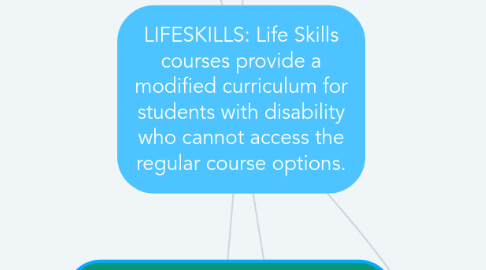
1. CONTENT: Differentiation by content involves adjusting knowledge, concepts, and skills that students need to learn based on the curriculum.
1.1. Providing alternative representations of teaching and learning materials such as using images, multimedia, braille or simplified texts
1.1.1. For example in my future classroom this could include using visual aids such as photographs, pictures or symbols to demonstrate key terminology and concepts.
1.2. Layered curriculum: This approach features a three tier model where students start with foundational knowledge and move onto higher order thinking skills as they move through the layers
1.2.1. Layer C: This layer reflects the basic learning and skills that all students must do. Students collect factual information
1.2.2. Layer B: In this layer students apply and manipulate the information gathered in layer C.
1.2.3. Layer A: In this layer students critically think and evaluate an issue.
1.3. Planning work which draws on student interest and is relevant to their context (Owen- Jackson, 2015)
1.3.1. Student's could be asked to adapt, make improvements or add a new feature to the design of an existing product rather than invent a new product
2. PRODUCT: Differentiation by product involves providing a variety of ways students can demonstrate their knowledge of the same skill or concept.
2.1. Multiple activities: Teachers set multiple activities to enable students to work on the same concepts but at different levels of proficienct
2.1.1. Activities can be based on students strengths, for example using 3D mock ups rather than drawings.
2.2. Open-ended task enable students to work at different levels and paces
2.3. Assess students work against their prior achievements rather than other students
2.4. Assessment
2.4.1. SELF ASSESSMENT: Additional scaffolding should be provided so students know where they are in relation to success criteria
2.4.1.1. Explicitly break down design and making stages into small and manageable steps
2.4.1.2. Use a tick or wall chart so that students are clear about what they are working towards and what steps they need to take to complete the project. This wall chart should use a combination of images and text as well as simplified language.
2.4.2. Processes
2.4.2.1. Provide additional scaffolds
2.4.2.1.1. word walls
2.4.2.1.2. visual aids
2.4.2.1.3. writing scaffolds
2.4.2.1.4. bilingual instruction
2.4.2.2. Additional time
2.4.2.2.1. In a technolgy classroom when students learn a new task they can be given additional time to practice before assessment
2.4.2.3. Use of a reader or scribe
2.4.3. Tasks
2.4.3.1. Rephrase the question
2.4.3.2. Use simplified language
2.4.3.3. Assess fewer syllabus outcomes
2.4.4. Format
2.4.4.1. Allow for students to submit assessments in a variety of modes
2.4.4.2. Point form rather than essays
3. DIFFERENTIATION: Tailoring the curriculum to meet individual students needs.
4. PROCESS: Differentiation by process involves adjusting the activities students use to master concepts or skills.
4.1. Flexible Grouping
4.1.1. Support groups for students who need additional targeted teaching
4.1.2. Consolidation groups for students performing at the expected level
4.1.3. Extension groups for students working beyond the expected level
4.2. Explicit teaching: provides students with a common understanding of new knowledge as well as opportunities for group and independent practice.
4.2.1. "I do": direct teacher instruction and demonstration
4.2.2. "We do": teachers model the new skill or knowledge, assess the general level of understanding and provide feedback to the group
4.2.3. "You do": teachers can provide individual feedback to students, set up small groups and provide targeted instruction
4.3. Flipped Classroom
4.3.1. Direct instruction happens online or at home
4.3.2. Class time is used for teacher to provide feedback and addressing individual needs
4.3.3. Students can revise content
4.3.4. Students can work ahead
4.4. Tiered Instruction: teachers make slight adjustments within a lesson to meet their students needs. Students learn through different modes and activities to achieve the same fundamental skills and concepts.
4.4.1. Tier by challenge level- Bloom's Taxonomy
4.4.2. Tier by complexity- providing varied tasks from introductory to more abstract
4.4.3. Tier by resources- use materials at varying reading levels
4.4.4. Tier by outcome- students use the same material to produce different products
4.4.5. Tier by process- students use a different process to get to the same outcome
4.5. Menus: These offer students a way of selecting what tasks they will complete to meet class requirements
4.6. Cubing: requires students to look at a topic from six different angles
4.6.1. Students work in assigned groups or pairs and each work on a different element of the cube. Groups can be organised based on the complexity of the perspectives.
4.7. Tic-Tac-Toe choice boards: Students select three of a possible 9 activities to practice skills or extend their understanding of concepts they've learnt in class.
5. LEARNING ENVIRONMENT
5.1. Where pupils will be seated
5.1.1. Seating should allow for easy teacher or peer support
5.1.2. Students can clearly hear and see easily
5.2. Use specialist presentation equipment for pupils with sight of hearing difficulties
5.2.1. Alternative communication systems, such as hearing loops and text talk
5.2.2. Visual presentations have close caption subtitles
5.3. Accessing support staff
5.4. Adjustments specific to a design and technology classroom
5.4.1. Using hand over hand support when using tools
5.4.2. Providing additional safety guards and PPE
5.4.3. Having tool preset
5.4.3.1. For example a compass could be fixed to a set radius
5.4.4. Making accommodations to ensure work areas are accessible
5.4.4.1. Adjustable height benches should be provided
5.4.5. Using assistive or adaptive devices
5.4.5.1. In a technology classroom this could include using adaptive grip paintbrushes or large handled scissors
5.4.5.2. Jigs can be created to aid cutting
5.4.5.3. In a textiles classroom patterns can be ready made, fabric could be precut, students could be provided with electric scissors a tagging gun could be used in place of pins
